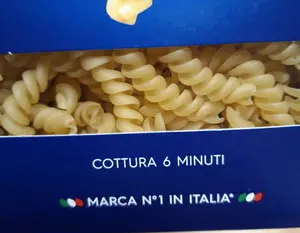This site uses only a few technical cookies necessary for its operation. By continuing to browse, you accept their use.
To find out more...
To find out more...
Cooking time for pasta

What is as good and simple as pasta? Not much, I think, and it's so easy to prepare: boiling water, salted (or not, depending on your taste), a few minutes of boiling and it's ready.
The only "difficulty", so to speak, is the respect of the cooking time and the risk of, unfortunately, overcooking your pasta.
The only "difficulty", so to speak, is the respect of the cooking time and the risk of, unfortunately, overcooking your pasta.
24 K 4.6/5 (19 reviews)
Keywords for this post:PastaTimeCookingAl denteItalyLast modified on: July 18th 2019
Cooking time for pasta
As always with pasta, we must take inspiration from the masters that are the Italians, they are very attached, and rightly so, to a rigorous and fair cooking, the famous "al dente".
Cooking is very precise: the pasta is plunged into boiling salted water and left for the precise number of minutes indicated on the packet, a number which depends on the nature of the pasta: 5, 6, 7 minutes or more, then drained and eaten or served.
Impossible to miss? In principle not, but there is a very easy mistake to make, it is to overcook, and thus to have overcooked pasta which becomes sticky, and much less good.
An Italian friend of mine pointed out to me that "At home" (in France) pasta is always overcooked, no matter where you go to eat it. It's not that it's inedible, just that it's a little overcooked, usually by a minute or so.
It's not always the cook's fault, the mistake is often already on the package, so she pointed me to this great tip.
Respect the time indicated precisely (here 6 minutes)
Subtract 1 minute from the indicated cooking time, so here 12 - 1 = 11 minutes.
With this simple rule, you should have pasta that is always al dente.
To sum up: The cooking time is indicated not in Italian on the package => subtract one minute from the indicated time, the cooking time is indicated in Italian, do not change anything.
Cooking is very precise: the pasta is plunged into boiling salted water and left for the precise number of minutes indicated on the packet, a number which depends on the nature of the pasta: 5, 6, 7 minutes or more, then drained and eaten or served.
Impossible to miss? In principle not, but there is a very easy mistake to make, it is to overcook, and thus to have overcooked pasta which becomes sticky, and much less good.
An Italian friend of mine pointed out to me that "At home" (in France) pasta is always overcooked, no matter where you go to eat it. It's not that it's inedible, just that it's a little overcooked, usually by a minute or so.
It's not always the cook's fault, the mistake is often already on the package, so she pointed me to this great tip.
If you have a package of pasta where it is written in Italian

Respect the time indicated precisely (here 6 minutes)
If you have a packet of pasta where it is written in a language other than Italian

Subtract 1 minute from the indicated cooking time, so here 12 - 1 = 11 minutes.
With this simple rule, you should have pasta that is always al dente.
To sum up: The cooking time is indicated not in Italian on the package => subtract one minute from the indicated time, the cooking time is indicated in Italian, do not change anything.
Lasts posts
Butter vs. grease
We often read in a recipe where a pastry is put into a mould that, just before pouring, the mould should be buttered or greased. But what's the difference between these 2 terms?December 1st 20259075
Getting out of the fridge early
Very often when you're cooking, you need to take food or preparations out of the fridge, to use them in the recipe in progress. There's nothing tricky about this: you just take them out of the fridge and use them, usually immediately, in the recipe. But is this really a good method?November 24th 20251,0595
Who's making the croissants?
When you look at a bakery from the outside, you naturally think that in the bakery, the bakers make the bread, and in the laboratory, the pastry chefs make the cakes. It's very often like that, with each of these professions having quite different ways of working, but sometimes there's also one...November 23th 2025955
Oven height
When we put a dish or cake in the oven, we naturally tend to put it on the middle shelf, and that's what we usually do. But in some cases, this position and height can be a little tricky, so let's find out why.October 8th 20252,6275
The importance of sieving
In recipes that use a fine powder (flour, powdered sugar, etc.), you'll often see the advice to sift before using it. To sift is to pass the powder in question through a sieve (a very fine strainer) before incorporating it into your recipe. It's often advice, but is it really useful?September 3rd 20257,4633
Other pages you may also like
Different kinds of pastry and dough
When cooking in general, and particularly in baking, we can make and use many different kinds of pastry and dough. All built on the same "base": flour - a powder to which we add fat, liquid or both to produce the dough which is then cooked. .November 6th 2012111 K 14.0
The return of the "Norman hole"
You maybe know the "trou normand", this old gastronomic custom typically French which consists in taking a (small) glass of calvados, generally between the last course and the dessert? It's something that seems a bit anachronistic nowadays, having a glass of an alcohol of more than 60° in the...December 18th 202115 K4.8
What is the difference between bakery and patisserie?
This is a question that you may well have asked yourself and which I will attempt to answer. In France the two trades of "boulangerie" (bakery) and "pâtisserie" (patisserie and confectionery) have always been quite distinct, but where exactly do the boundaries lie? .February 7th 2017134 K 14.1
The dissociation of a preparation
It may have already happened to you: You prepare a sauce, a cream, a ganache etc. and then suddenly or almost, the whole thing dissociates, and from a smooth mixture that you were preparing with love, you end up with a horrible thing with a more or less solid part and another liquid part. It's...January 22th 202212 K4.9
A few tips for effective kneading at home
When you have to knead dough for bread or some other recipe, you may well use a food processor or the type of machine known as a stand mixer. The best-known brands are Kenwood and KitchenAid. They are useful tools, but here are a few tips to help you get the best out of them.June 23th 2021284 K 23.8
Post a comment or question
Follow this page
If you are interested in this page, you can "follow" it, by entering your email address here. You will then receive a notification immediately each time the page is modified or a new comment is added. Please note that you will need to confirm this following.
Note: We'll never share your e-mail address with anyone else.
Alternatively: you can subscribe to the mailing list of cooling-ez.com , you will receive a e-mail for each new recipe published on the site.









